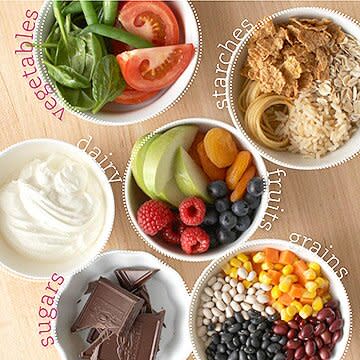What Are Carbohydrates? A Quick Guide to Carbs
Become a Carb Expert

Along with the diagnosis of diabetes comes a new vocabulary. One of the most frequently used -- and misunderstood -- terms is "carbohydrate."
"Confusion about carbohydrate still reigns," says Johanna Burani, R.D., CDE. "People I counsel are surprised to learn milk, yogurt, and fruits contain carbohydrate and are convinced that pasta, bread, and ice cream 'turn to sugar' and shouldn't ever pass their lips again."
Yet carbohydrate is essential for healthy eating. As a person with diabetes, it's important to learn how to unscramble the carb puzzle.
Tip: 30 Healthy Low-Carb Foods to Eat
Foods with Carbohydrate

Think of foods as packages of nutrients – combinations of carbohydrate, protein and/or fat. "No one food has all the nutrients your body needs, which is why eating a wide variety of foods helps you meet your nutrition needs,"Burani says. The three main calorie-containing nutrients are carbohydrate, fat, and protein. (Alcohol also contains calories.) Most of the calories in the following foods are from carbohydrate. - Starches: bread, cereal, pasta, whole grains - Starchy vegetables: potatoes, corn, legumes (beans) - Fruit: Apples, berries, melon, and fruit juice - Nonstarchy vegetables: green beans, tomatoes, broccoli - Dairy: milk, yogurt, cheese - Sweets and sugary foods: ice cream, chocolate, regular soda, candy
What Are Healthy Sources of Carbs?

What makes sources of carbohydrate healthy? Your goal should be to choose carbohydrate-containing foods that offer vitamins, minerals, and fiber -- what dietitians call nutrient-dense foods. Nutritionist Johanna Burani encourages people to eat foods she calls "tricklers," which slowly raise blood sugar after eating -- whole grains, unprocessed, and fiber-filled foods rather than refined starches and sugar-laden foods and drinks that contain negligible nutrients and lots of calories.
Often, similar-size servings of two carbohydrate-containing foods have about the same amounts of calories and carbs, however one may be a better choice nutrition wise. For example, 1/2 cup of orange juice with pulp (fiber) and fortified with calcium and vitamin D offers more nutrition than 1/2 cup of orange drink. The calories from the orange drink are mainly from added sweeteners with nearly no nutritional value.
Why Carbs Matter

Why focus on carbohydrate when you have diabetes? Because the carbohydrate in foods has the most impact on blood glucose, especially the first couple of hours after you eat.
"Most people with type 2 diabetes who don't take insulin can use what dietitians call basic carb counting," says Karen Bolderman, R.D., CDE, PWD type 1. "With this approach to meal planning you learn the foods that contain carbohydrate and how much carb to eat at meals each day."
You want to eat enough carbohydrate to fuel your body, but not more than needed to achieve weight and blood sugar goals. Work with a registered dietitian or diabetes educator to determine personalized goals based on your needs.
"Advanced carb counting is taught to people who take insulin several times a day using multiple daily injections or an insulin pump. With this method people learn to adjust their meal-time rapid-acting insulin dose based on their blood glucose level and the amount of carbohydrate they're going to eat," Bolderman says.
What Is Carb Counting?

Carb counting is simply a method of diabetes meal planning, which became more popular in the U.S. after completion of the NIH-funded Diabetes Control and Complications Trial (DCCT) in type 1 diabetes. Carb counting doesn't prescribe a certain amount of carbohydrate to eat -- it's goal is to help people learn how to include healthful carb-containing foods in their diet; plan meals that contain sufficient amounts of carbs; fit in a wide variety of foods (even sweets); and balance this with necessary blood glucose-lowering medications, all while controlling blood sugar levels.
What's the difference between carb grams and carb choices? They're essentially the same. The concept of carb choices morphed from the diabetes exchange system, which is being used less and less today. The exchange system is simply another approach to teach meal planning to people with diabetes. In that system, one starch, fruit, or milk exchange contains, on average, 15 grams of carbohydrate.
Because most people read food labels and use nutrient data to look up carb counts of the foods they eat, counting carb grams is more accurate. That's particularly important if you're determining doses of rapid-acting insulin.
How Many Carbs to Eat

Dietitians agree that the following starting points for carb grams or choices per meal work for many people. Don't severely limit or avoid carbs to control blood sugar -- you'll compromise your healthful eating plan and be less likely to control your blood sugar or weight over time.
A note about the list below: If you are of average size, your carb counts per day and per meal are between the small and large sizes (for example, an average size woman should eat 45-60 g carb per meal).
Carb Counts per Day:
Smaller Woman: 135 g carb. or 9 carb choices
Larger Woman: 180 g carb. or 12 carb choices
Smaller Man: 180 g carb. or 12 carb choices
Larger Man: 225 g carb. or 15 carb choices
Carb Counts per Meal:
Smaller Woman: 45 g carb. or 3 carb choices
Larger Woman: 60 g carb. or 4 carb choices
Smaller Man: 60 g carb. or 4 carb choices
Larger Man: 75 g carb. or 5 carb choices
1 carb choice = 15 grams of carbohydrate
The U.S. government's dietary guidelines suggest eating 45-65 percent of your calories from carbohydrate sources. The 2013 nutrition recommendations from the American Diabetes Association (ADA) suggest you eat sufficient carbohydrate to meet your nutrients needs and to focus on eating nutrient-dense sources of carbs, including vegetables, fruits, whole grains, legumes, and dairy foods. If you attempt to greatly trim your carb intake -- especially if you eat fewer than 1,500 calories a day -- you just won't get the vitamins, minerals, and fiber you need.
Improve Your Carb-Counting Accuracy

A few tried-and-true suggestions from the experts -- dietitians and people with diabetes (PWDs):
- Check the total carb count on the nutrition facts label against the serving size. Is this the amount you should eat? "When I began to focus on portion control, I realized my portions were huge," says Kelly Cupp, PWD type 2.
- Visualize, visualize, visualize. "At home, weigh and measure the common items you eat -- potatoes, rice, dry or cooked cereal. Then you'll better recognize the right portions when you're away from home," says author Karen Bolderman, R.D., CDE, PWD type 1.
- Write it down. Use a permanent marker to note the serving sizes and carb counts on the sides of boxes and cans in your pantry that contain multiple servings. "You'll see at a glance how much to count," says Kelly Rawlings, PWD type 1.
The Low-Carb Diet Debate

Research on very low-carb diets has revealed no benefits for controlling weight, blood lipids (cholesterol), or blood glucose, especially when followed for longer than six months. Still, there's much debate about carbohydrate's role in diabetes eating plans. Advocates span the carbohydrate spectrum -- from the low side, such as Atkins diet or paleo diet advocates, to a higher-carb, no-animal-products approach, such as vegetarianism or veganism.
But one thing shouldn't be ignored: "Studies show that when people with diabetes cut back on carbohydrate, they eat more fat, often the unhealthy saturated fat, which has been shown to contribute to insulin resistance and less-well-controlled diabetes," says Marion Franz, R.D., CDE, a nutrition and diabetes consultant from Minneapolis.
Weight loss studies also don't support the use of very low-carb diets (under 135 grams of carbohydrate daily). The food plan shown to truly work for long-term weight control is eating less fat and getting about half of your total daily calories from carbohydrate.
"The American Diabetes Association reinforces the importance of zeroing in on an amount of carbohydrate that is healthy and meshes well with your food preferences and eating style for the long haul," Franz says.
Why Low-Carb Isn't a Wonder Cure

Following a healthy meal plan day in and day out is essential for living well with diabetes. However, initially or over time, it might not be enough to keep you from needing blood glucose-lowering medications. Because of the natural progression of both pre-diabetes and type 2 diabetes, by the time most people are diagnosed with type 2, they've been losing insulin production progressively for five to 10 years and less than half (or more) of their insulin-producing cells are working. Eating fewer carbs does little to halt this process, and eventually blood glucose-lowering medications are required. What has shown to be helpful in slowing the disease progression is losing 7 percent of body weight and keeping as much of that off as possible. Add to this regular physical activity nearly every day, totaling at least 150 minutes per week.
In fact, the ADA now recommends that people diagnosed with type 2 diabetes begin taking at least one blood glucose-lowering medication right away. Most guidelines recommend starting with metformin for a few reasons – it's generic and inexpensive, plus it's safe and has been used for many years. Metformin works by helping the body make better use of the insulin it continues to produce.
Carb-Counting Resource: Nutrition Labels

The most accurate information is at your fingertips. Read food packages for the total carbohydrate grams (it's less important to pay attention to the grams of sugars because they're factored into the total grams of carb). Be sure to note how many serving sizes are in a package of food or bottled beverage. If you only consider the grams of carb per serving, but the package has three servings, then you could potentially triple the carb grams you think you are eating if you consume the entire package.
Carb-Counting Resources: Books, Websites & Apps

Nutrition information, in particular carb grams, is available in books and also in easy-to-access apps and websites. Having the carb counts of the foods you eat often can be very helpful to increase your carb-counting accuracy. When it comes to restaurant eating, some books, apps, and websites offer this information, but if you want information on the carb counts of foods from large restaurant chains, go to their websites. It will likely be a few clicks away.
Start with these books:
* The CalorieKing Calorie, Fat & Carbohydrate Counter by Allan Borushek (Family Health
Publications, 2014)
* The Diabetes Carbohydrate & Fat Gram Guide, by Lea Ann Holzmeister, R.D., CDE
(American Diabetes Association, 2010)
* Guide to Healthy Restaurant Eating, by Hope S. Warshaw, R.D., CDE
(American Diabetes Association, 2009)
Start with these websites:
Today there are countless websites and apps to assist you with looking up carb counts, tracking what you eat, totaling your carb counts, and much more. Many apps are free. Check out a few to see which one you enjoy using, and very importantly, will continue to use over time.
* supertracker.usda.gov/default.aspx
Try these mobile apps: